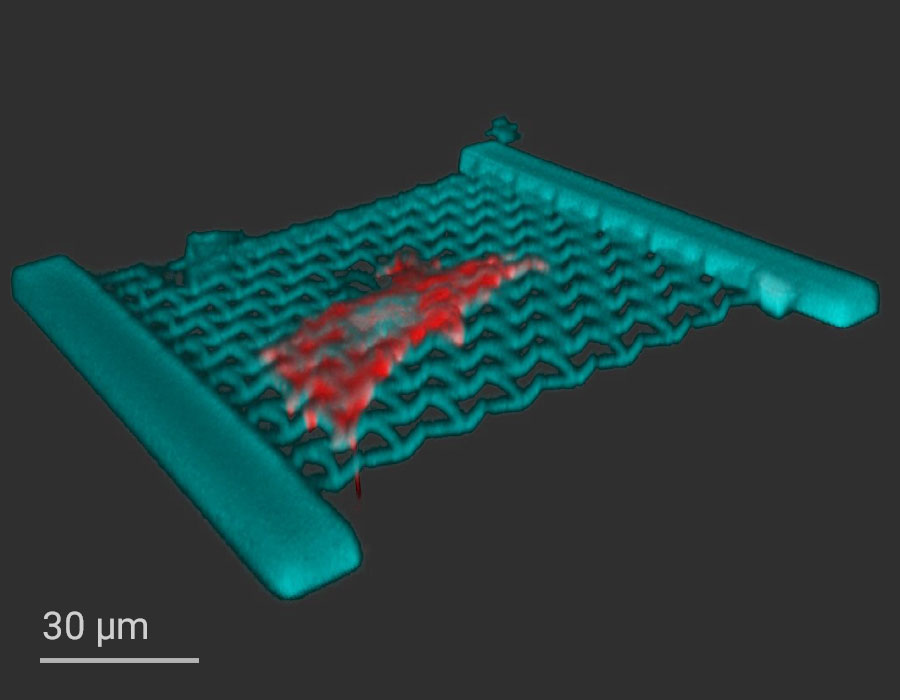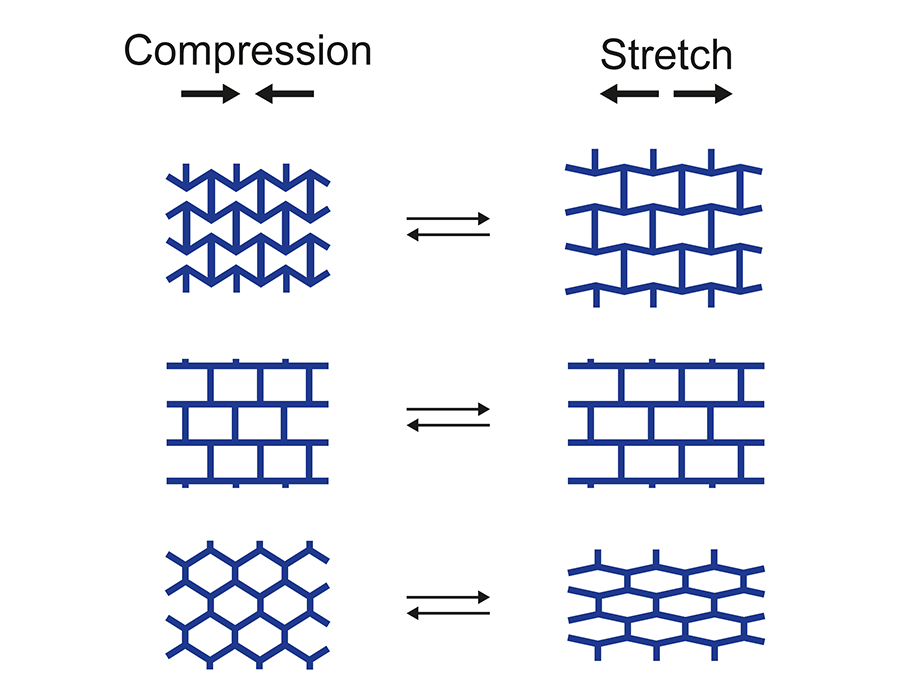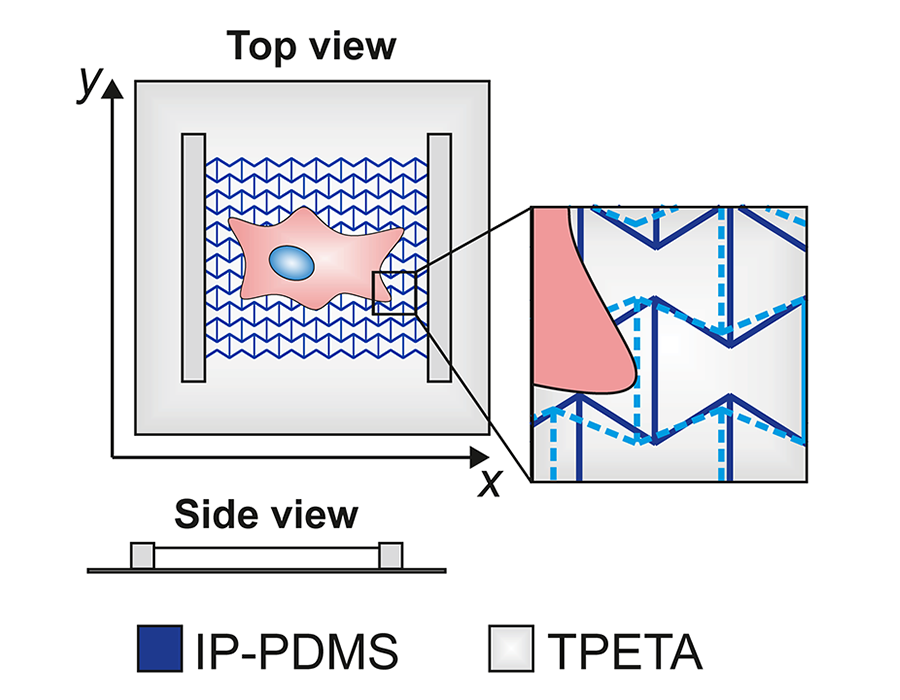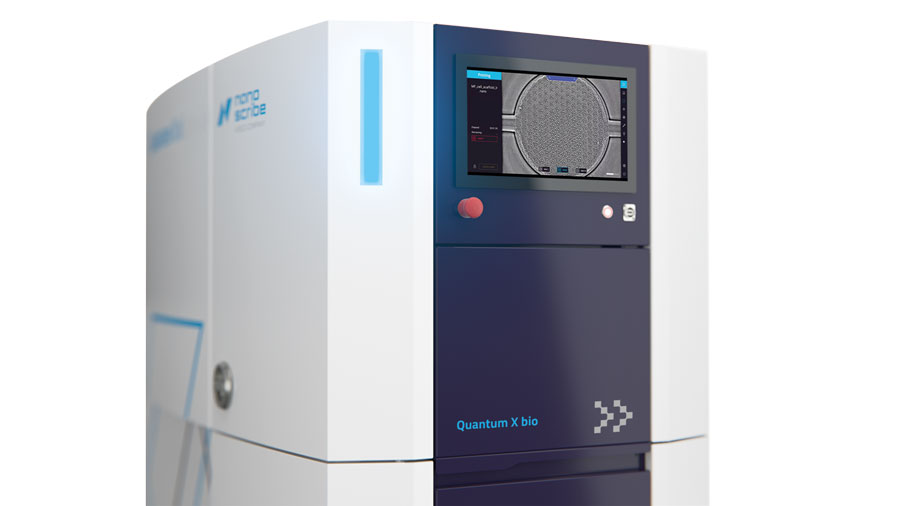The effective elastic properties of bio-metamaterials can significantly influence cells cultured on suitable metamaterials as substrates. Recent advances in 2-photon lithography with silicon elastomer-like materials enable the creation of microstructured bio-metamaterials meeting cell size and deformability criteria. In this study, human mesenchymal stem cells (hMSCs) are cultured on metamaterials fabricated through Two-Photon Polymerization using IP-PDMS as a photoresin. The effective elastic properties of these bio-metamaterials significantly affect the response of cells on a cellular and molecular level. This proof of principle experiment provides a foundation for designing future bio-metamaterials as potential tools for understanding and controlling the mechanical behavior of stem cells and other cell types through effective mechanical properties by the arrangement of unit cells.
Elastic 3D-printed bio-metamaterial
for cell regulation
Due to their intentionally designed microstructure, metamaterials demonstrate extraordinary properties that are uncommon in natural materials. Versatile in mechanics, electromagnetism/optics, and transport, metamaterials show promise as biomaterials, termed "bio-metamaterials". However, using them to control the behavior of living cells remains a challenge in material science. Researchers at KIT, Uni Heidelberg and Uni Kyoto have tackled this challenge and succeeded in producing sufficiently soft suspended metamaterials, with unit cell sizes below the cellular scale. With a Nanoscribe Photonic Professional system, using Two-Photon Polymerization, they fabricated these networks from a soft, silicon elastomer-like photoresist, held in place by two rigid walls.
3D printing of bio-metamaterials
Nanoscribe utilizes Two-Photon Polymerization (2PP) as a key technology for high-resolution 3D printing, allowing for the creation of metamaterial unit cells at sizes significantly smaller than those of stem cells. This innovative approach not only demonstrates the precision of 2PP-based 3D printers but also facilitates the intricate construction of two-dimensional (2D) metamaterial architectures. This level of precision paves the way for designing customized materials with highly anisotropic properties.
IP-PDMS enables small feature metamaterials
The critical factor in attaining the necessary deformation through active cell contraction lies in material selection. Opting for IP-PDMS, the softest resin in Nanoscribe's IP series, the scientists used a photoresin with a bulk Young’s modulus of 15.3 MPa, showcasing remarkable elasticity—three orders of magnitude smaller than the popular IP-S resin. This choice enables achieving the required soft mechanical behavior while maintaining sufficiently small features for small metamaterial periods. The synergy of IP-PDMS and Nanoscribe’s 3D Microfabrication technology holds significant potential for innovative applications in life sciences, microfluidics, and micromechanics.
Engineering cellular responses with 2PP bio-metamaterials
The novel Two-Photon polymerized bio-metamaterials provides mechanical regulation of cell behaviors by the effective mechanical properties derived from unit cell arrangement. The researchers created a novel class of bio-metamaterials to serve as a precisely defined model for manipulating cellular mechanics. In order to assess distinct cell responses, three metamaterial structures (bowtie, brickstone, and honeycomb) were fabricated using TPETA and IP-PDMS, all exhibiting similar polymer surface area fractions. Identifying the significant impact of the effective elastic properties of bio-metamaterials on the cellular and molecular behavior of cells cultured on compatible metamaterial substrates provides fundamental insights. This proof-of-principle serves as both motivation and an initial step for the systematic design of future bio-metamaterials, aiming to serve as a tool for comprehending and potentially exerting mechanical control over the behavior of stem cells and other cell types.
Control of temperature, humidity and sterility
The scientists attained impressive outcomes by stretching the dynamic range of IP-PDMS to its limits through the utilization of the 63x objective for higher resolution, even though the resin was originally optimized for printing with the 25x objective. This underscores the incredible capabilities of the printing system they employed, which enabled them to overcome technical constraints and achieve advancements in their field.
With Quantum X bio, Nanoscribe’s next generation system, scientific investigations are conducted under optimal experimental conditions, featuring precise temperature and humidity control, HEPA-filtered airflow, and optional connections for pre-mixed air/CO2, ensuring better quality at higher speed with more reliable results.



Quantum X bio offers unparalleled 3D bioprinting capabilities, from subcellular to millimeter scale microfabrication, to meet the multiple needs in life science research. It allows printing in sterile cell culture dishes, on microscope slides, or inside microfluidic chips, accommodating diverse setups. Researchers have the flexibility to customize materials according to specific needs, thanks to the variety of photoresins available and the option to utilize third-party resins.
Would you like to find out more about this inspiring project? Then read the open-access publication here: Bio-Metamaterials for Mechano-Regulation of MesenchymalStem Cells
This and further scientific publications on more than a thousand research projects from Nanoscribe customers and system users can be found in a powerful database with a keyword search in the Premium resources section. Register for free to see for yourself the potential of Nanoscribe’s 3D Microfabrication technology for innovative applications and fundamental innovations in many areas, and to evaluate its suitability for your project.
Video information
Innovative bio-metamaterial design showcased: Metamaterial is manufactured by 2PP-based 3D printing, highlighting intricate details with dynamic response of a human mesenchymal stem cell (hMSC) to bowtie shaped bio-metamaterial. Video: Karlsruhe Institute of Technology (KIT) + Heidelberg University


